Cotoneaster, a member of the rose family (Rosaceae), is a diverse genus encompassing hundreds of varieties. Originating from several regions in Asia and Europe, including the Himalayas, these plants are classified as non-native in the UK. Like many non-native species, cotoneaster was initially introduced for its ornamental attributes. Surprisingly, despite five species being designated as ‘invasive,’ they are still readily available in UK garden centres and nurseries. Some commonly selected species include Cotoneaster horizontalis, Cotoneaster simonsii, and Cotoneaster frigidus ‘Cornubia.’ Notably, two out of these three are listed as invasive in Schedule 9 of the Wildlife and Countryside Act 1981, underscoring the significance of accurate cotoneaster identification.
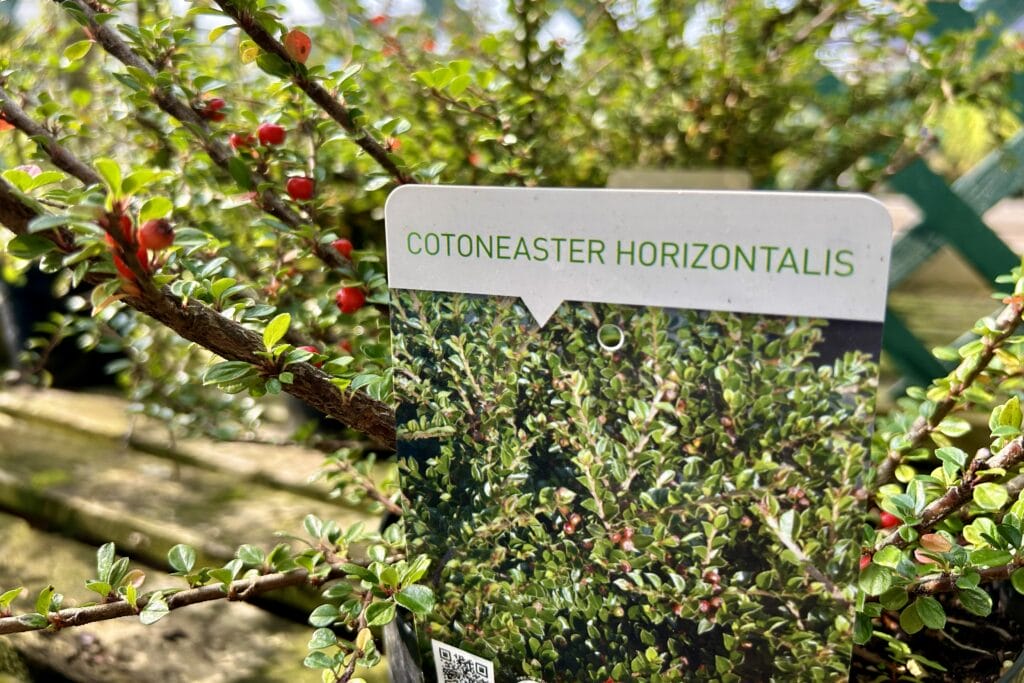
Cotoneaster horizontalis for sale at a garden centre © PBA Solutions
What does cotoneaster look like?
Leaves are very typically dark green and glossy, though they can vary in size. Hollyberry cotoneaster (Cotoneaster bullatus) has larger leaves than Cotoneaster horizontalis or Cotoneaster integrifolius. Both the latter have leaves smaller than a centimetre in length, that cluster tightly on their woody stems. Cotoneasters are generally hardy, tolerating a wide range of soil conditions and sun exposures. However, they do exhibit a number of different growth habits.
Cotoneaster can have attractive berries of pink, red or orange. These berries are eaten by birds, for whom they are not toxic. The successful spread of cotoneaster seeds by birds is one of the reasons this plant group has become invasive in the UK. However, not all wildlife can eat the berries. They are poisonous to some, with the possibility of cyanogenic glycoside toxicity occurring if consumed by humans or pets.
Cotoneaster species identification
Cotoneaster species identification is useful if you have pets or children, to minimise the chances of the toxic berries being ingested. However, you should also consider whether you have an invasive cotoneaster species in your garden. If so, you have an obligation to prevent its spread into the wild.
Identifying the species of cotoneaster will also be important for the general maintenance of the plant. Several of the following cotoneaster species are commonly found in UK gardens. Care needs to be taken in handling any pruned stems and soil containing the roots or seeds. This material is considered ‘controlled waste’ and should be properly disposed of at a licensed landfill.
Wall cotoneaster (Cotoneaster horizontalis)
Cotoneaster horizontalis, commonly named ‘wall cotoneaster’, is the variety now established in the UK, raising the most concerns with its invasive behaviour. This deciduous shrub, often seen along walls and urban areas, regularly extends beyond its intended boundaries. Performing well in various soil types, its adaptability has led to a negative impact on some local UK ecosystems.
Characterised by its dark green elliptical leaves, the herringbone pattern of the stems, and its clusters of small small red berries. The plant’s arching stems are woody with dark brown bark and paler cracks. These distinctive stems forms tiers, which together produce a basket-like appearance. In May to late-spring, delicate pinkish-white flowers appear which will turn to bright red berries in the autumn.
Still available for purchase; however, its invasive tendencies in the UK have raised ecological alarms. When landscaping in the UK, first consider planting species that are native or non-invasive.
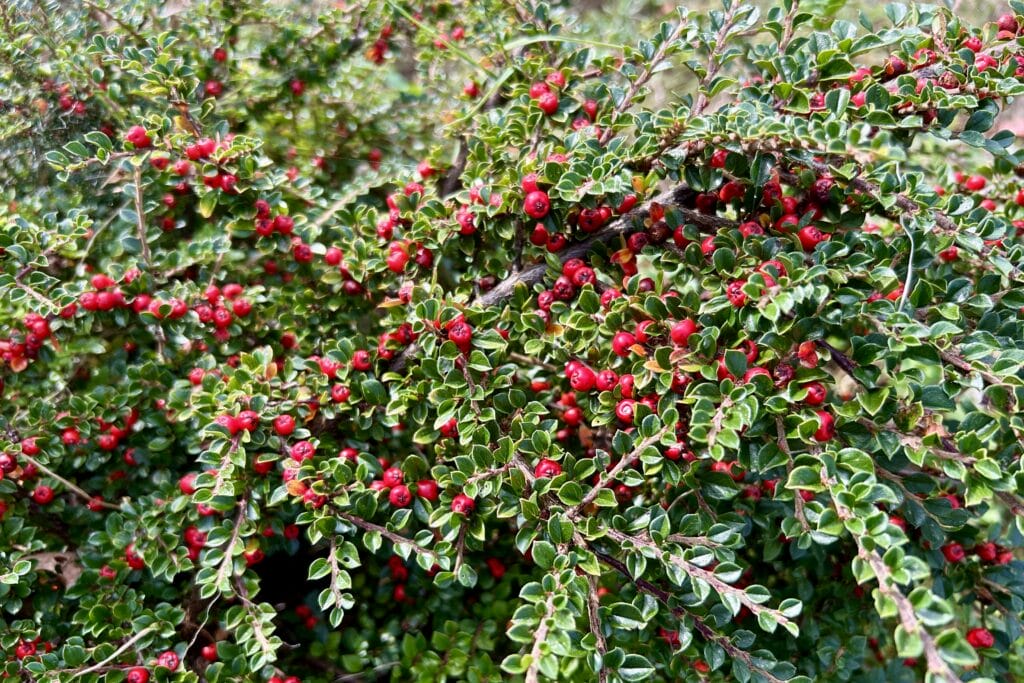
Cotoneaster horizontalis, or wall cotoneaster, in a raised flower bed © PBA Solutions
Himalayan cotoneaster (Cotoneaster simonsii)
Cotoneaster simonsii, more commonly known as Simon’s Cotoneaster or Himalayan Cotoneaster, is renowned for its robust growth habit. Typically reaching heights of 2-3 metres, this versatile shrub is often used for hedging purposes. Its dense and bushy appearance has made it popular for creating natural boundaries and enhancing landscape designs. However, given its invasive nature, it is crucial to exercise caution when contemplating the inclusion of Himalayan cotoneaster in any landscaping projects, particularly in ecologically sensitive areas.
This distinctive variety of cotoneaster also features small, dark green, oval leaves. However, in late spring, the shrub graces its branches with white flowers that often have a hint of pink. The most striking feature of Cotoneaster simonsii is its vivid scarlet berries. These berries, notably larger than those of other common cotoneaster species, serve as an enticing food source for local bird populations. This upright, hardy cotoneaster variety can be found throughout the British Isles, extending as far north as Scotland. It is important to approach its use with caution, to ensure that it doesn’t contribute to unwanted ecological disruptions in local ecosystems.<p><br>
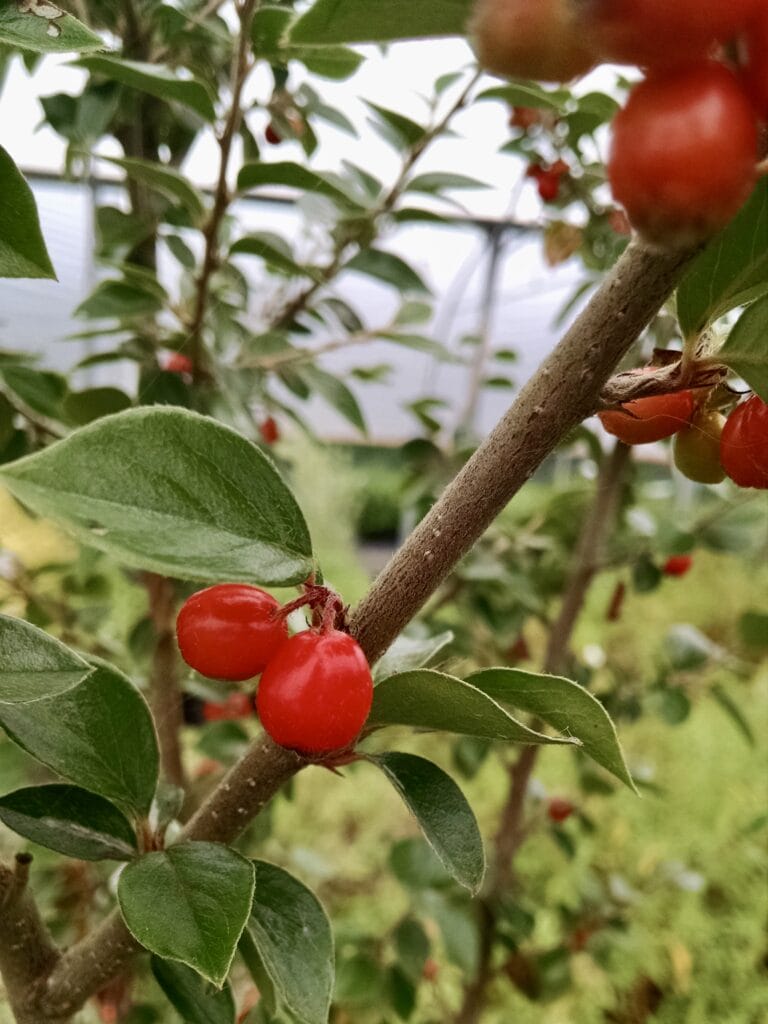
Close-up of bright red berries & green leaves on an upright stem of Cotoneaster simonsii iStock/John Caley
Small-leaved cotoneaster (Cotoneaster microphyllus)
Cotoneaster microphyllus, also referred to as Small-leaved Cotoneaster, is another of the low-growing varieties. An evergreen shrub that typically reaches heights of around 30 centimetres to 1 metre with a dense, creeping growth habit.
One of its key identifying characteristics is the presence of diminutive, dark green, oval leaves. These are usually less than 1cm in length, giving rise to its common names, Small-leaved or Littleleaf cotoneaster. During late spring, Cotoneaster microphyllus showcases dainty, five-petaled white flowers that later form small, deep-red berries.
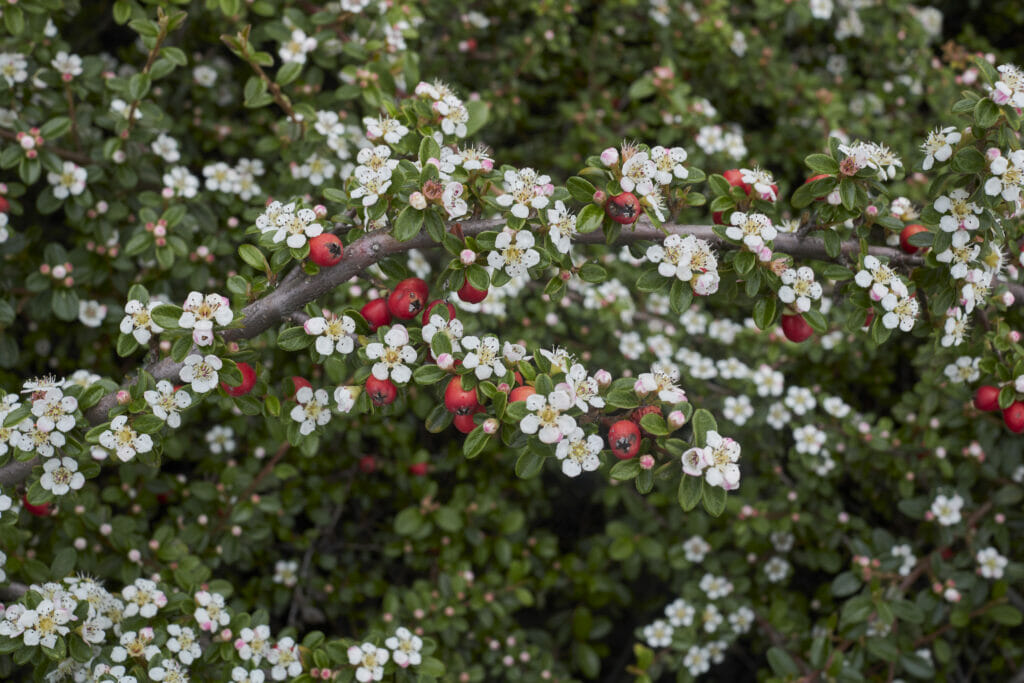
Cotoneaster microphyllus iStock.com/seven75
Entire-leaved cotoneaster (Cotoneaster integrifolius)
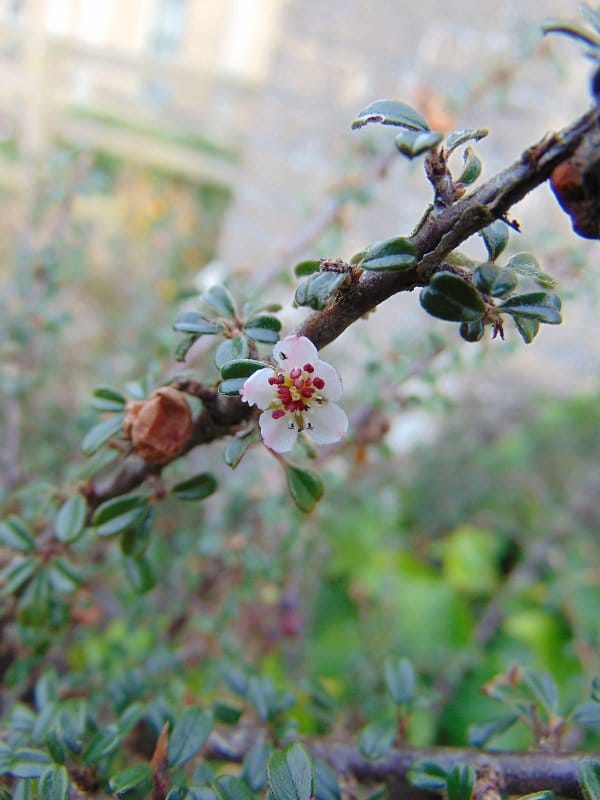
Cotoneaster integrifolius Paul Green https://twitter.com/WexfordBotany1
Cotoneaster integrifolius, also recognized by its alternative names, including Entire-leaved Cotoneaster, is a visually appealing yet invasive shrub. This ornamental plant is often featured in public rock gardens, adding a touch of elegance to these landscapes. One distinctive feature of Cotoneaster integrifolius is its strikingly large flowers, setting it apart from some other cotoneaster species with less significant blooms. Its abundance of five-petaled white flowers during late spring and early summer provides a delightful ornamental display.
A challenge identifying Cotoneaster integrifolius is that it is sometimes mistaken for Cotoneaster microphyllus due to their similar growth habits. However, one of the key distinguishing characteristics is the size of the flowers, with Cotoneaster integrifolius bearing larger blossoms. Its leaves are small and oval, contributing to its overall charm. It’s important to be aware of its invasive potential, especially in regions where it poses a threat to local ecosystems. When incorporating this visually appealing shrub into landscaping projects, consider alternative, non-invasive plant species to preserve the ecological balance and health of the local environment.
Hollyberry cotoneaster (Cotoneaster bullatus)
When identifying Cotoneaster bullatus, the size and shape of its leaves stand out as a key identifying feature. This substantial plant typically reaches impressive heights of 3-4 metres and boasts large, deeply veined, glossy dark green leaves. These leaves not only stand out in terms of their size but also their visual impact for landscaping.
In summer, the plant produces pale pink flowers, that later form clusters of small red berries. Whilst, during autumn this variety comes into its own. Cotoneaster bullatus undergoes a spectacular transformation, as the foliage turns a brilliant blend of orange and red, creating a striking display in gardens and landscapes.
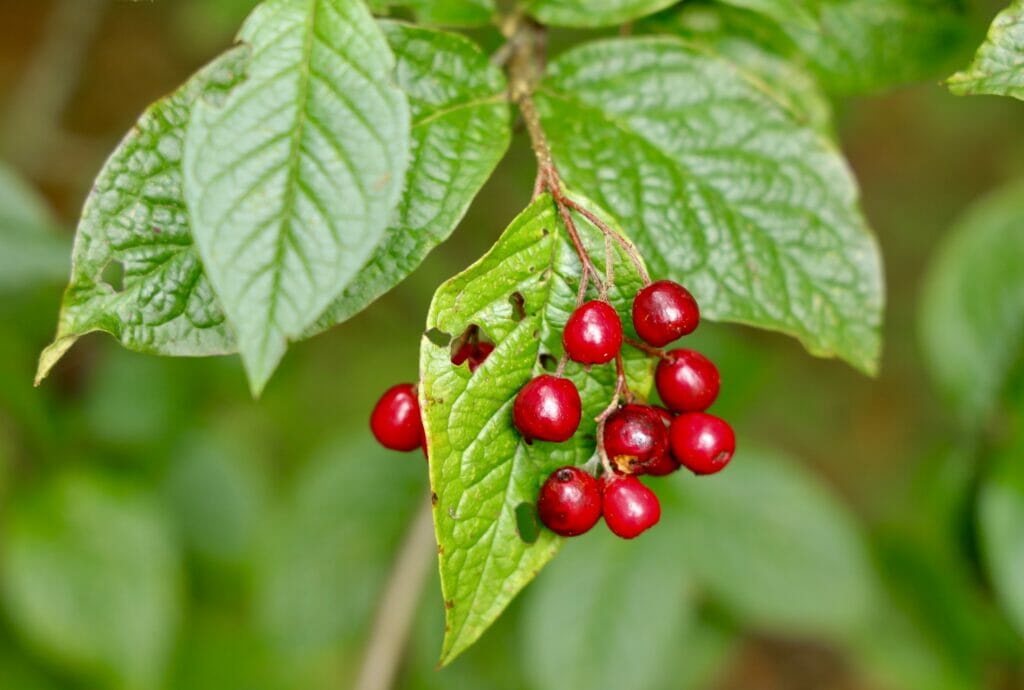
Cotoneaster bullatus iStock.com/yujie chen
Is cotoneaster poisonous to animals?
While cotoneaster berries are a favored food source for birds, it’s important to note that they can be toxic to certain animals. Cotoneaster species contain a toxic chemical, so exercising caution is essential when incorporating these plants into your garden or allowing pets or children, who may be curious and ingest the plant, to roam freely.
Be aware that all parts of Cotoneaster species contain varying amounts of cyanogenic glycosides, which can be harmful if ingested in significant quantities, potentially leading to gastroenteritis. Horses, in particular, are highly susceptible to cyanide poisoning, which could occur if they consume cotoneaster foliage or berries, as both parts contain cyanogenic glycosides.
It’s worth mentioning that Cotoneaster frigidus ‘Cornubia’ is one of the cotoneaster species that is not considered invasive and has even received recognition as an RHS award winner. It is a popular choice for many gardens, often grown as a large and bushy shrub. Cotoneaster frigidus ‘Cornubia’ contains cyanogenic glycosides, just like other invasive and non- invasive species
Are cotoneaster berries poisonous to dogs?
Cotoneaster berries are generally considered to be mildly toxic to dogs. While they may not be as toxic as some other plants, they can still cause gastrointestinal upset and discomfort if ingested. Symptoms of mild poisoning in dogs can include vomiting, diarrhea, and stomach cramps.
It’s important to note that the toxicity level may vary depending on the specific Cotoneaster species, the quantity of berries consumed, and the individual dog’s sensitivity. If you suspect that your dog has ingested cotoneaster berries or any potentially toxic plant, it is advisable to contact your vet for guidance on how to proceed.
Is cotoneaster toxic to cats?
Cotoneaster contains cyanogenic glycosides which, similarly to dogs, make cotoneaster toxic to cats if a large quantity of it is ingested.
Dogs and cats usually aren’t badly affected following ingestion of cotoneaster berries, but gastrointestinal signs may occur. Any suspected poisoning should be treated as an emergency and the attention of a vet sought out immediately. Severe Cotoneaster poisoning is rare as the foliage and berries are very bitter and unpalatable, though it is more likely to occur in herbivores.
Should I remove cotoneaster?
Though an attractive plant, there are compelling reasons to consider removing cotoneaster from your garden. Cotoneasters are a non-native species in the UK, which can quickly outcompete native plants. Spreading the invasive species of cotoneaster is an offence against the Wildlife & Countryside Act 1981, with fines and/or sentences associated with allowing the plant to spread into the wild. Cotoneaster berries are easily dispersed by birds which means it can rapidly take over small garden spaces or be spread to vulnerable habitats.
Often, specialist or professional assistance will be required for the removal or management of invasive plants. This will ensure that the appropriate legislation is followed, particularly with regard to the disposal of plant and contaminated soil waste. At PBA Solutions, we deal with a wide range of invasive plant species and are happy to offer identification assistance and offer advice on the best solutions.
If you are concerned about the spread of Cotoneaster horizontalis, simonsii, bullatus, or any of the other invasive or non-invasive cotoneasters, call 0203 174 2187 or 01202 816134 to talk to one of our consultants today.
Lead image © PBA Solutions

